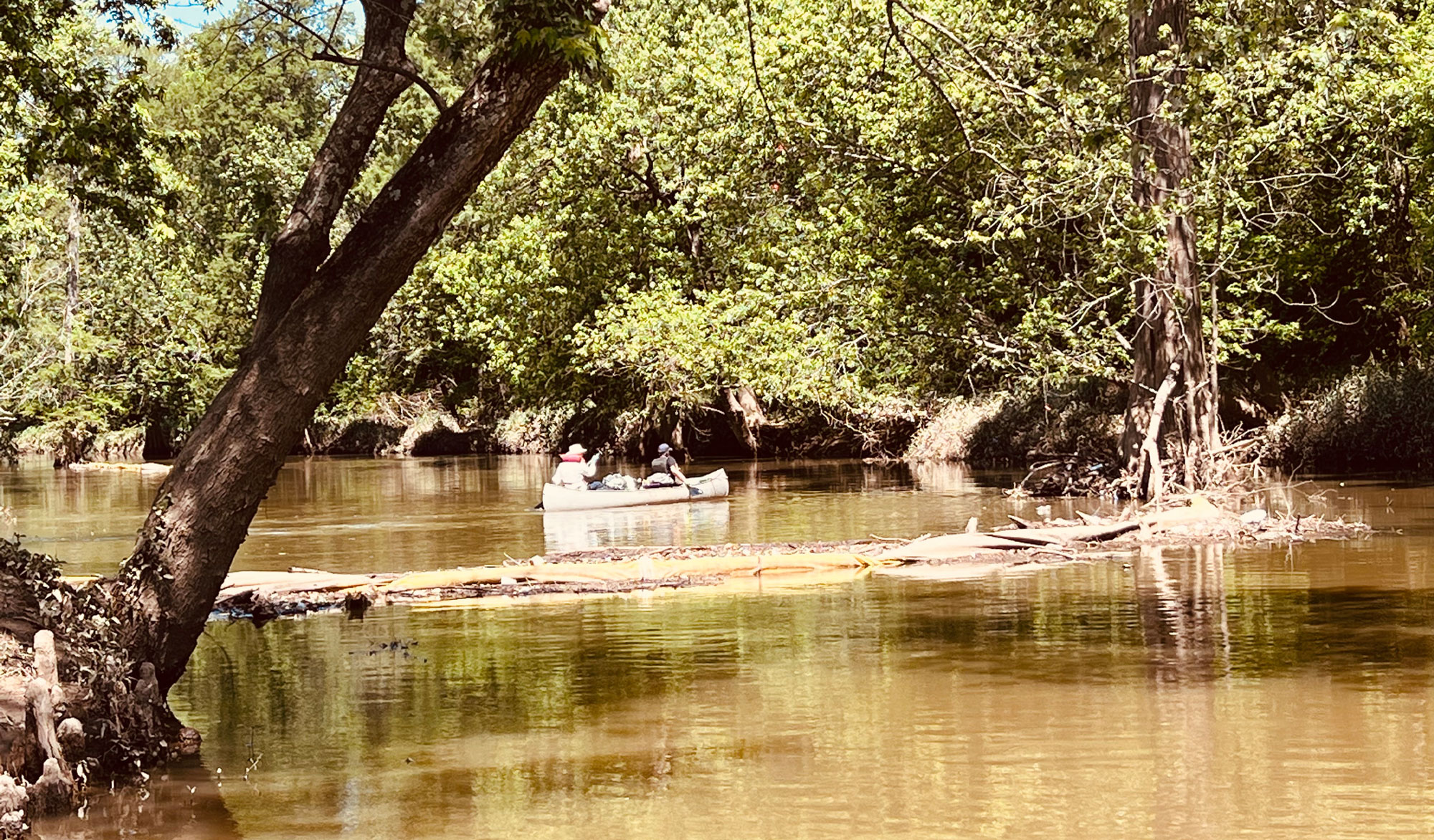Talking Trash
Boom Blast Helps A Local Urban Wetland To Heal.
Story and Photography by Christopher Wyman

Volunteers paddle Fourche Creek, picking up trash in order to preserve the natural beauty of the area.
Born and raised in Little Rock, I have attained a mountain man mentality with an emphasis on mindful homesteading cultivation. I am familiar with Fourche Creek and the boarding flood plains known as the bottoms, the urban wetlands of Little Rock. However, I only recently experienced this ecological gem located in the middle of The Natural State.
The journey began with a phone call to Norm Berner to start “trash talking” as he sometimes calls it. Norm, who is a board member of the nonprofit group known as Keep Little Rock Beautiful, the municipal branch of the state organization Keep Arkansas Beautiful, is also a founding member of the Friends of Fourche Creek and a large-scale figure attempting to bring awareness to Fourche Creek and the wetlands. He and others have gained traction recently by alerting the city board members to the need for trash removal from the area.
It takes a village to gain such grassroots traction. Partnerships with like-minded groups include the Central Arkansas Master Naturalists (CAMN), the Arkansas Game and Fish Commission, the city of Little Rock Parks and Recreation, The Little Rock Sustainability Commission, and local canoe clubs like the Arkansas Canoe Club Black Ops Advanced Trash Retrieval (ACC BOATR). Thanks to these organizations and generous volunteers, trash removal is ongoing.
The process is simple. Trash booms are strategically placed in the waterway to help catch items in large, confined areas where it is then removed by volunteers during BOOM BLAST events held at Benny Craig Park in Little Rock every second Saturday of the month. Basically, “BOOMS” are floating trash interceptors and look like a long, semicircle-shaped floating buoys. When I experienced this catch-and-removal process firsthand, I felt as if I had done some truly satisfying work and made a difference.
Since efforts began in 2020, over 30,000 pounds of trash have been removed from Fourche Creek. On the BOOM BLAST event I participated in on May 11, the amount totaled to 30,208 pounds of trash, a mind-blowing amount.
Oil containers of all varieties, clothing, recreational sports equipment, fast-food bags, plastic bottles, tires and broken furniture all gum up the waterways … and the list goes on. Use your imagination and visualize what you see as “trash.” If you throw it out, it’s no longer your problem, it’s everyone’s problem. It happens every day. Someone drops a fast-food bag or styrofoam cup out on the road instead of in a proper trash receptacle. Those items eventually make their way to the watershed and into the waterway where it disrupts the environment’s ecological balance. There is a ripple effect.

Spanning 112 square miles, the Fourche Creek watershed in Little Rock acts as a vital filter for 108,000 surrounding acres, managing runoff from over 70% of the city and receiving water from 15 tributaries.
If you throw it out, it’s no longer your problem, it’s everyone’s problem.
Fourche Creek spans some 112-square-miles. The watershed itself acts as a filter and drainage system for the 108,000 acres of surrounding area. This includes the majority of Little Rock runoff at over 70% of the area draining into the Fourche from rain and flooding. There are 15 tributaries that flow into the Fourche, as well. If left alone, trash eventually makes its way to the Arkansas River, onward to the Mighty Mississippi, and eventually ends up in the Gulf of Mexico. Development over time of city infrastructure like highways and railways removes the greenspace that slows the runoff, but ultimately the trash ends up in the wetland area and the waterway.
The good news is that it can be restored. Through generous grassroots and volunteer-led efforts, our urban wetland is beginning to heal.
More BOOMS will eventually be placed in tributaries like Coleman Creek and Rock Creek to help combat the issue before it can make it to the wetlands. “The wetland area in Little Rock is the largest urban wetlands in the South and the third largest in the country at 1,800 acres. The stretch of wetlands suitable for recreational waterway use and land trails is known as the Southwest Trail. This would be the largest natural park in the city,” Berner said.
I was fortunate enough to experience a private boat ride with Reed Green, a retired United States Geological Survey hydrologist (limnology) and member of CAMN. In his retirement, Green still works as an adjunct professor of biology and earth sciences at UA Little Rock. Green describes the area where the booms collect the trash perfectly: “So ugly yet so beautiful. And then you realize the paradox.”
Green and Berner took me to the recreational waterway area of Fourche Creek that is part of the Southwest Trail, which will also include a land trail that follows part of the waterway. It is a leisurely paddle, with jaw-dropping beauty amongst the forest of cypress, tupelo and hardwoods.
For those that love to canoe and kayak but may not have the time to leave the city, this recreational waterway is a worthwhile float filled with scenic beauty and wildlife. All Arkansas recreational waterways have their charm and unique outdoor experience. Fourche Creek is very much a bayou-style wetland like that of Dagmar State Wildlife Management Area or Bayou Meto. Flooded timber hosts an abundance of habitat for a plethora of wildlife.
Bird watching, ecotourism, outdoor education, hiking and fishing are all available at the Fourche. The noise pollution from a bustling city is nonexistent due to the natural growth of bountiful foliage that acts as a sound barrier. This is a place to reflect and to be with one’s self.
Through generous efforts of many, this gem of an urban wetland has already begun to heal. The conservation and environmental cleanup efforts will only continue. To get involved on the next BOOM BLAST, visit keeplittlerockbeautiful.com for more information.
Christopher Wyman is a conservationist based in Little Rock. He has over two decades of experience in urban gardening and wildlife management.


